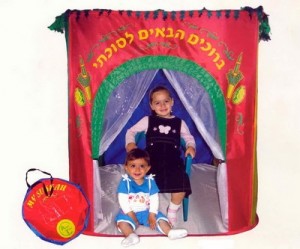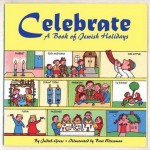Growing up, were you one of those kids who, at least once a summer, pestered your parents to let you have a camp-out in the backyard? The whole idea was so thrilling. After days of planning the big event, you’d spend the whole afternoon setting up the tent, gathering up sleeping bags and flashlights and buying junk food. (Did anyone think to ask about a weather report?)

Predictably, somewhere between the last scary story and the first strange animal sound, you’d scurry inside to the comfort and safety of your bedroom.
The Jewish holiday of Sukkot, which literally means “booth”, is always a favorite with kids because it’s like a dream come true for the outdoor adventurer in them. Jews are actually directed to eat, sleep and say special blessings in a temporary outdoor structure for seven days. It’s how we commemorate God’s watching over the Jews during the forty years they wandered in the desert and lived in temporary shelters.
We take this directive from Leviticus 23:42, which says, “You will dwell in booths for seven days; all natives of Israel shall dwell in booths.”
Sukkot begins five days after Yom Kippur, one of the most solemn Jewish holy days of the year. It’s no wonder that Sukkot is referred to in our prayers as Z’man Simchateinu or Season of Rejoicing. This year it runs from sunset on September 30 to nightfall on October 7.
The first two days of the festival are a major holiday, and most forms of work are off limits. It’s also considered an autumn festival to celebrate the harvest – something like the American Thanksgiving.

I always know when Sukkot is close because the sukkahs (temporary shelters) start popping up on driveways in my neighborhood. Jewish tradition requires that the sukkah have two and a half sides made of a material that won’t blow away in the wind. The roofing, called sekhakh, must be made of something that grew in the ground and was cut off, such as tree branches, corn stalks or even lumber.
In some parts of the U.S., mostly the Northeast, Jews decorate their sukkah with dried corn and various squash to celebrate the fall season.
Daily during the seven days of Sukkot (except Shabbat), we take part in the observance of the “Four Kinds.” Leviticus 23:40 tells us, “On the first day, you will take for yourselves a fruit of a beautiful tree, palm branches, twigs of a braided tree and brook willows and you will rejoice before the Lord your God for seven days.”
And so we’re to take four plants – an etrog (a citrus-like plant native to Israel), a palm branch, two willow branches and three myrtle branches. All but the etrog are bound together, and we say a blessing while waving the bundle east, south, west, north, up and down, to remind us that God is everywhere.

